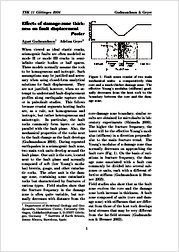Effects of damage-zone thickness on fault displacement
Gudmundsson, Agust
Geyer, Adelina
Universitätsverlag Göttingen
Sammelband- / Konferenzbeitrag
Verlagsversion
Deutsch
Gudmundsson, Agust; Geyer, Adelina, 2006: Effects of damage-zone thickness on fault displacement. In: Philipp, S.; Leiss, B; Vollbrecht, A.; Tanner, D.; Gudmundsson, A. (eds.): 11. Symposium "Tektonik, Struktur- und Kristallingeologie"; 2006, Univ.-Verl. Göttingen, S. 79 - 81., , DOI: 10.23689/fidgeo-1905.
 |
Dokument öffnen: |
When viewed as ideal elastic cracks,
seismogenic faults are often modeled as
decreases from the host rock to the
boundary between the core and the damage
zone.
mode II or mode III cracks in semiinfinite
elastic bodies or half spaces.
These models normally assume the rock
to be homogeneous and isotropic. Such
assumptions may be justified and necessary
when using closed-form analytical
solutions for fault displacement. They
are not justified, however, when we attempt
to understand fault-displacement
profiles along earthquake rupture sites
or in paleofault studies. This follows
because crustal segments hosting faults
are, as a rule, not homogeneous and
isotropic, but rather heterogeneous and
anisotropic. In particular, the fault
rocks commonly form layers or units
parallel with the fault plane. Also, the
mechanical properties of the rocks next
to the fault change as the fault develops
(Gudmundsson 2004). During repeated
earthquakes in a seismogenic fault zone,
two main rock units develop around the
fault plane. One unit is the core, located
next to the fault plane and normally
composed of soft (low Young’s modulus) breccia, gouge, and other cataclastic
rocks. The other unit is the damage
zone, containing some cataclastic
rocks but characterized by fractures of
various types...

